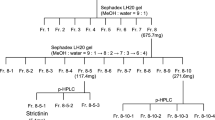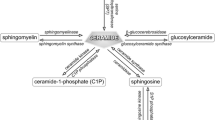Summary
We have studied the effect of etretin (Ro 10-1670), the active metabolite of the widely used antipsoriatic drug etretinate (Ro 10-9359), on the incorporation and release of arachidonic acid in human skin keratinocytes. During 24-h culture, radioactive 14C-arachidonic acid was avidly incorporated into the cellular lipids of the keratinocytes. When the cells were cultured for another 48 h in fresh medium, 8.8%±0.3% of the incorporated radioactivity was released from the cells. The presence of etretin (10-8 M to 10-5 M) in the medium stimulated the release of radiolabel. With 10-5 M etretin in the culture medium, 13.0%±0.4% of the incorporated radioactivity was released, and this was accompanied by decreased labelling of phosphatidylethanolamine. This suggests that phosphatidylethanolamine may be an important source of the released arachidonic acid.
Etretin pretreatment reduced the incorporation of 14C-arachidonic acid into diacylglycerols, triacylglycerols, and cholesteryl esters. Pretreatment for 48 h with 10-5 M etretin reduced subsequent 14C-arachidonic acid incorporation into nonphosphorus lipids from a mean total of 8.2%±0.2% to 3.2%±0.1% (p<0.001). These findings suggest that etretin interferes with the esterification of arachidonic acid into nonphosphorus lipids. Etretin was also found to cause changes in the fatty acid composition of keratinocytes. Following 48 h culture with etretin, the percentage amount of the fatty acids belonging to the n3 series was increased whereas that of palmitic acid (16:0) and palmitoleic acid (16:1n7) was decreased. In conclusion, our study suggests that etretin in therapeutical concentrations affects fatty acid metabolism in human keratinocytes in culture.
Similar content being viewed by others
References
Black AK, Fincham N, Greaves MW, Hensley CN (1980) Time course changes in levels of arachidonic acid and prostaglandin D2, E2, F2α in human skin following UVB irradiation. Br J Clin Pharmacol 10:453–457
Brain SD, Camp RDR, Dowd PM, Kobza Black A, Woollard PM, Mallet A, Greaves MW (1982) Psoriasis and leukotriene B4. Lancet 2:762–763
Ellis CN, Kang S, Grekin RC, LoBuglio AF, Voorhees JJ (1985) Etretinate therapy for psoriasis. Reduction of antibody-dependent cell-mediated cytotoxity of polymorphonuclear leukocytes. Arch Dermatol 121:877–880
Fukuzawa K, Chida H, Tokumura A, Tsukatani H (1981) Antioxidative effect of tokopherol incorporation into lecithin liposomes on ascorbic acid-Fe2+-induced lipid peroxidation. Arch Biochem Biphys 206:173–180
Hänni R (1978) Pharmacokinetic and metabolic pathways of systemically applied retinoids. Dermatologica 157 [Suppl 1]:5–10)
Irvine RF (1982) How is the level of free arachidonic acid controlled in mammalian cells? Biochem J 204:3–16
Kitano Y, Okada N, Nagase N (1983) Metabolism of an aromatic retinoid Ro 10-9359 by cultured human epidermal keratinocytes. Arch Dermatol Res 273:327–331
Kragballe K, Voorhees JJ (1984) Arachidonic acid and leukotrienes in dermatology. J Invest Dermatol 81:293–298
Kunze H, Vogt W (1971) Significance of phospholipase A for prostaglandin formation. Ann NY Acad Sci 180:123–125
Levine L, Ohuchi K (1978) Retinoids as well as tumour promoters enhance deacylation of cellular lipids and prostaglandin production in MDCK cells. Nature 276:274–275
Mack J, Lui N, Roels O, Andersson O (1972) The occurrence of vitamin A in biological membranes. Biochim Biophys Acta 288:203–219
Marcelo C, Bartel R, Fortune J (1986) Effect of retinoids and glucocorticoids on phospholipase A2 and C mediated release of arachidonic acid by murine keratinocyte cultures. J Invest Dermatol 86:491
Orfanos CE, Bauer R (1983) Evidence for anti-inflammatory activities of oral synthetic retinoids: experimental findings and clinical experience. Br J Dermatol 109:[Suppl 25]:55–60
Orfanos CE, Steigleder GK, Pullman H (1979) Oral retinoid and UVB radiation: a new, alternative treatment for psoriasis on an out-patient basis. Acta Derm Venereol (Stockh) 59:241–244
Perry VP, Sanford KK, Evans VJ, Hyatt GW, Earle WR (1957) Establishment of clones of epithelial cells from human skin. JNCI 18:709–717
Ponec M (1984) Retinoid-induced changes of lipid synthesis in cultured human epidermal keratinocytes. Br J Dermatol [Suppl 27]: 242–247
Punnonen K, Puustinen T, Jansén CT (1986) Incorporation and distribution of dihomo-γ-linolenic acid, arachidonic acid, and eicosapentaenoic acid in cultured human keratinocytes. Prostaglandins 31:263–270
Punnonen K, Puustinen T, Jansén CT (1986) The effect of the antipsoriatic drug metabolite etretin (Ro 10-1670) on UVB irradiation induced changes in the arachidonic acid metabolism in human keratinocytes in culture. Photochem Photobiol 44:623–628
Punnonen K, Puustinen T, Jansén CT (1986) UVB irradiation induces changes in the distribution and release of 14C-arachidonic acid in human keratinocytes in culture. Arch Dermatol Res 278:441–444
Punnonen K, Puustinen T, Jansén CT (1987) UVB irradiation induces changes in the distribution and release of arachidonic acid, dihomo-γ-linoleic acid, and eicosapentaenoic acid in human keratinocytes in culture. J Invest Dermatol 88:611–614
Puustinen T, Uotila P (1983) Dipyridamole interferes with the incorporation of arachidonic acid and stimulates prostacyclin production in rat lungs. Prostaglandins 26:265–274
Ree K, Johnsen AS, Rygstad HE, Bakka A, Hovig T (1981) Characterization of a human epithelial cell line with special reference to its ultrastructure. Acta Pathol Microbiol Immunol Scand A 89:73–80
Roels OA, Anderson OR, Lui NST, Shah DO, Trout ME (1969) Vitamin A and membranes. Am J Nutr 22:1020–1032
Rollman O, Vahlquist A (1983) Retinoid concentrations in skin, serum and adipose tissue of patients treated with etretinate. Br J Dermatol 109:439–447
Ruzicka T, Printz MP (1984) Arachidonic acid metabolism in skin: review. Rev Physiol Biochem Pharmacol 100:121–160
Samuelsson B (1983) Leukotrienes: mediators of immediate hypersensitivity reactions and inflammation. Science 220:568–575
Samuelsson B, Goldyne M, Granström E, Hamberg M, Hammarström S, Malmsten C (1976) Prostaglandins and thromboxanes. Ann Rev Biochem 47:997–1029
Ziboh VA, Lord JT (1979) Phospholipase A activity in the skin. Modulators of arachidonic acid release from phosphatidylcholine. Biochem J 184:283–290
Ziboh VA, Price B, Fulton J (1975) Effects of retinoic acid on prostaglandin biosynthesis in guinea-pig skin. J Invest Dermatol 65:370–374
Author information
Authors and Affiliations
Rights and permissions
About this article
Cite this article
Punnonen, K., Puustinen, T. & Jansén, C.T. The antipsoriatic drug metabolite etretin (Ro 10-1670) alters the metabolism of fatty acids in human keratinocytes in culture. Arch Dermatol Res 280, 103–107 (1988). https://doi.org/10.1007/BF00417713
Received:
Issue Date:
DOI: https://doi.org/10.1007/BF00417713




